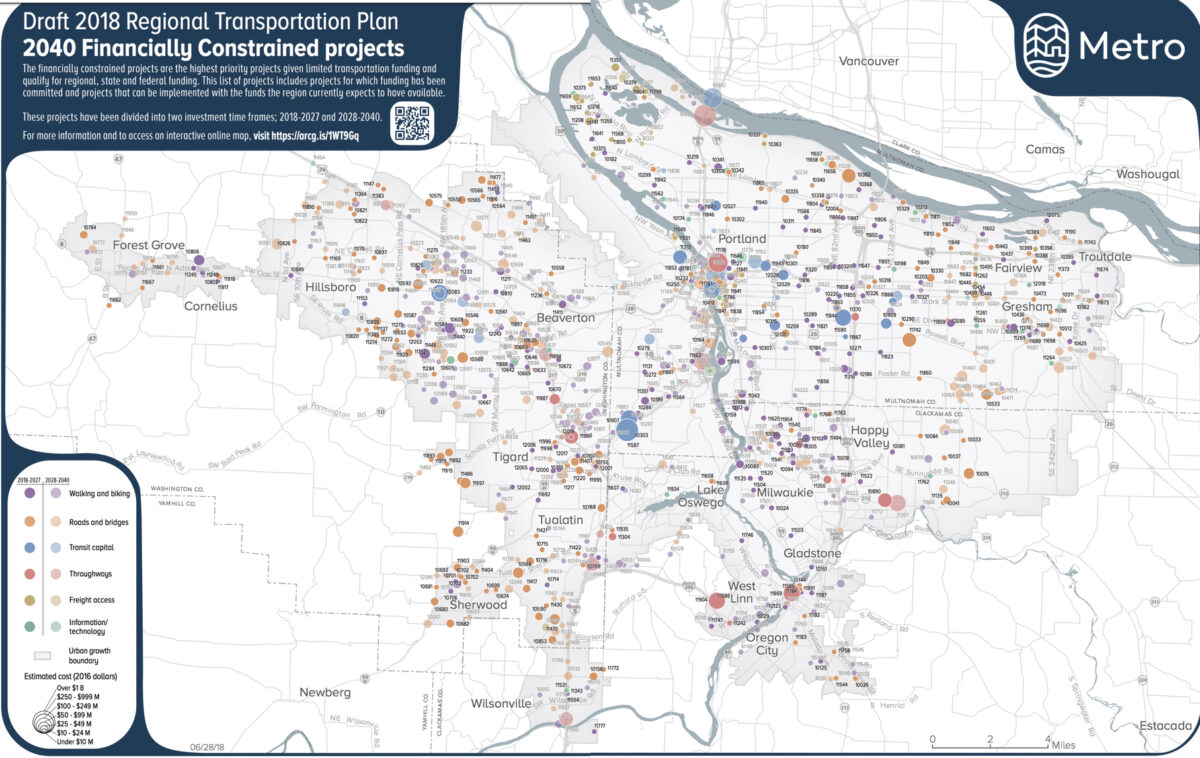
“While this plan isn’t the best we can do, it reflects the best we can do right now.”
— from Metro’s RTP Formal Comment Period Briefing Book
When it comes to major infrastructure projects, if it’s not in Metro’s Regional Transportation Plan (RTP), it’s not going to be built. And as our region faces growing population pressure, a mobility revolution, and the impacts of climate change, it’s imperative that the projects listed in this plan reflect our highest values and priorities.
For the past three years Metro and their partners have been working to update the RTP and we’re now just five months away from formal adoption. But before that happens, councilors and policymakers need to hear what you think. An official public comment period is now open and runs through August 13th.
The RTP includes over $42 billion of investment in the regional transportation system over the next 25 years split between $27 billion for maintenance/operations and $15 billion for capital projects.
Here’s more from Metro’s website:
The Regional Transportation Plan is a blueprint to guide investments for all forms of travel – driving, walking, biking and taking transit – and moving goods and services throughout the greater Portland region.
The updated vision for the future represents an aspirational view and reflects the values and desired outcomes expressed by the public, policymakers and community and business leaders.
Vision: By 2040, everyone in the greater Portland region will share in a prosperous, equitable economy and exceptional quality of life sustained by a safe, reliable, healthy and affordable transportation system with travel options.
It’s no surprise that we need more resources to achieve everything we need to keep this region a great place. While this plan isn’t the best we can do, it reflects the best we can do right now and moves us closer to our vision for a safe, reliable, healthy and affordable transportation system with travel options.
That “isn’t the best we can do” part is curious. It’s almost as if the plan’s authors know it needs to be more bold and less influenced by politicians afraid of rattling the status quo. This is where your comments come in.
Advertisement
The RTP is split into two sections: policies and projects. The policy section defines our values and goals and the project section is meant to be a reflection of them. The project list is separated into two categories: constrained and strategic. The constrained list is where the action is because those are the projects that are more likely to actually be built before 2040. The strategic list are more wishful projects that will require funding beyond what’s projected to be available. Projects are also categorized according to two estimated construction timeframes of 2018-2017 and 2028-2040.
Moving projects between these categories is one of the ways your comments can have a tangible impact on this plan.
Don’t think comments matter? Earlier this year a coalition of advocates expressed major concerns with an earlier version of the RTP project list. Their letter to Metro resulted in major changes.
Here’s how the plan currently doles out the $15.4 billion of constrained projects:
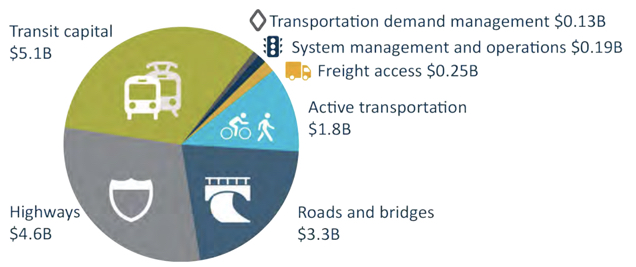
And this chart lays out the projects by volume and cost. (Note how inexpensive the bike/walk projects are and how Metro calls freeways “throughways”.)
A quick look at the interactive map shows some big projects like:
➤ The I-5, I-205, and OR 217 freeway expansions
➤ The Division Transit project
➤ I-5 Bridge replacement to Vancouver (formerly known as the Columbia River Crossing), estimated to cost $3+ billion
➤ Streetcar extension on Broadway to Hollywood Transit Center
➤ SW Corridor Light Rail
➤ NE 42nd Ave Bridge Replacement including bike facilities
Other smaller, yet very important projects on the list include several projects that will improve safety and fill pathway gaps on Marine Drive (we’ll share more about that effort in a separate post).
Metro has several ways you can add your voice to this process: take the online survey, comment in person at the Metro Council meeting tomorrow (Thursday, August 2nd), or send an email to transportation@oregonmetro.gov. To learn more about the RTP, I recommend the helpful “briefing book for policymakers“.
From here, Metro’s advisory committees will draft their own recommendations in October and the full Metro Council will consider adoption of the final RTP in December.
— Catie Gould (@Citizen_Cate) and Jonathan Maus (@jonathan_maus)
Never miss a story. Sign-up for the daily BP Headlines email.
BikePortland needs your support.



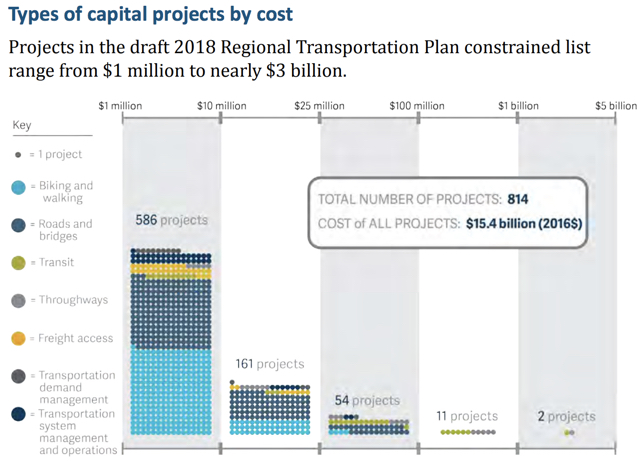
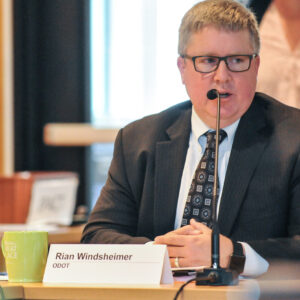
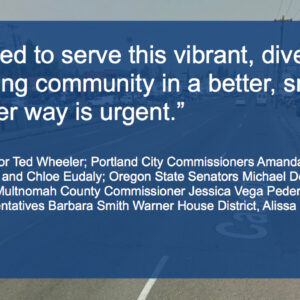
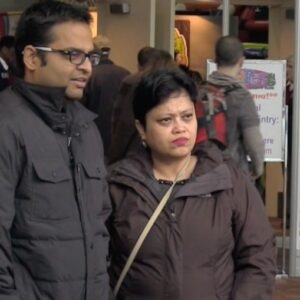

Thanks for reading.
BikePortland has served this community with independent community journalism since 2005. We rely on subscriptions from readers like you to survive. Your financial support is vital in keeping this valuable resource alive and well.
Please subscribe today to strengthen and expand our work.
Glad to see the Interstate Bridge(s) replacement on the plan. The need for this project has not gone away and hopefully this time Washington State can compromise on extending light rail. Things are only going to get worse if the only options are driving or getting stuck in traffic on the bus. Perhaps even a new rail-only bridge could be part of this project – Amtrak from downtown Portland to Vancouver, WA is literally a 5 minute ride, but the privately-owned BNSF bridge is at capacity – would be great to have an actually commuter line across the river that’s much faster than MAX. Guaranteed it would be heavily used from day one.
This isn’t meant to be snarky, but why is an Interstate Bridge replacement necessary? From my standpoint, I’ll admit that I’m not particularly interested in attempting to relieve congestion for suburban car commuters. And, sure, an express train would be great for those suburban commuters. But it still feels like subsidizing suburban sprawl which is generally unsustainable (but, hey, if Clark County wanted to pay for an express train for their residents, we can have that discussion.)
I would support express bus only lanes on the current bridge. That’s a cheaper solution than replacing a bridge which would cost billions.
If this is a question of safety, then we need to address the fact that gas taxes are seemingly inadequate to fund maintenance for the infrastructure we already have.
I agree that a new billions-dollar bridge is not ideal, however the current bridges are not seismically stable nor do they provide room for much else besides cars. If we are going to build a new bridge, I’d rather see it built to accommodate all modes without adding lanes for cars. Subsidizing suburban sprawl is not a good idea, but neither is ignoring the fact that lots of people are driving into Portland from Washington. I’d rather give those people more options. And as downtown Vancouver, WA densifies, wouldn’t it be nice to connect our two cities downtowns via rail?
It is interesting that the primary reason given for the $3.2bn I-5 bridge is “Relieve current congestion”. Other projects have reasons such as “Increase travel options/alt. to driving alone” or seismic upgrades. It is very troubling that this $3.2bd is to make it quicker/less aggravating to drive vehicles. Our transportation priorities seem not really to have budged.
I’d love to get the opinion of someone who has to navigate that bridge daily. Seems like the only people against a wider bridge are ones who do not use it.
There are spillover impacts from the congestion the bridge causes – more neighborhood traffic as people try to find on ramps that are not as busy, for instance. The traffic backing up on on Rosa Parks and Killingsworth, for example. People will be taking more sidestreets to avoid these streets. An uncongested highway will at least reduce the amount of neighborhood traffic that we will see more of if nothing is done.
Not to mention shipping. It really is pretty crazy that the major west coast interstate is a drawbridge here.
That drawbridge lifts less than once a day, and is prohibited from lifting during rush hours.
This is a key way that hugely expensive projects are marketed: find an anecdote, and say “isn’t this crazy?” (another example of this effort: “the Rose Quarter is the only place I-5 is two lanes of through traffic” – ignoring all the lanes on I-405 and I-205 that move traffic north-south).
It taps into the way humans think, but is not a good way to make decisions.
The core question isn’t: is this annoying?
But rather: is this the best thing we can do with $4,000+ million?
Considering both I-5 and the Interstate Bridge are both six lanes wide, I don’t see how a wider bridge would help anything, since the rest of I-5 isn’t being widened past six lanes. I can see how the narrow lanes and lack of shoulder on the existing bridge could be a bottleneck, which a new bridge would address. I just can’t see how an eight car-lane bridge would help anything – likely the bottleneck would just be pushed elsewhere along the highway.
The only capacity that should be added to the new bridge should be space for high-capacity transit (MAX and bus lanes). A wider bike path would be welcome as well, as the existing narrow sidewalk is a bit nerve-wracking.
3. Different work schedules.
4. Work from home.
5. Work from satellite offices.
6. Remove roads to make more room for housing.
I’m sure there are others….
7. Optimize operation of the freeway as a means of moving cars and trucks by removing on-ramps, or any one on-ramp. For pennies on the dollar you could build a separate bridge to Hayden Island and close that on-ramp.
I’m assuming they just haven’t got around to bike-washing the I-5 Columbia river project yet, eg. when they started claiming that the I-5 Rose quarter $500m was to improve surface street “connectivity” and “Reduce minor or non-injury crashes” on the freeway.
I agree Clicky. The current bridge is a hazard and I think we should Demo it, and let the cheapskates in Clark County and beyond pay to build a new one if they want to come over here so bad. I haven’t crossed that bridge in 10 years and won’t miss it if it were gone.
There are people who don’t use bike lanes and would not miss them if they were not there.
Being only one of two bridges in the metro area that cross the Columbia and the only one that connects straight to downtown Vancouver, I would consider a bike path to be a very important part of this project. Considering the bridge’s prominence and the tiny fraction of the overall cost a bike path would occupy, I see no reason not to include it.
Three billion dollars could surely rebuild every orphan highway in the Portland metro area and make the road diet for SW Scholls Ferry Road in Multnomah County.
Washington has the nation’s second-highest gas tax.
Yet 71% of WSDOT’s budget is to pay for debt. They have too many other cost overruns and partially built highway megaprojects, and too much deferred maintenance, in areas with more political influence, to find money for this boondoggle.
https://usa.streetsblog.org/2018/07/23/washington-dot-chief-fixing-congestion-with-highways-fiscally-impossible/
2nd highest state gas tax isn’t really something to brag about when it’s only 49.4 cents + 18.4 cents (Federal). The average total gas tax in advanced economies is $2.62/gallon.
Except for a few crumbs thrown to bikers, peds and light rail commuters, it appears that most of the spending will be on freeway enhancements.
On the topic of Metro calling Freeways Thruways, this is obviously a nod to the future of demand based tolling . I do regard that as a good step as it signals the internalization of the inevitability of demand based tolling on urban thruways in Oregon.
I just can’t find it in me to support tolls. It’s a Rube Goldberg device with so much extra overhead for everyone and every agency involved when a simple gas tax would do. Drive a bigger vehicle? Gas tax accounts for that. Drive more often? Gas tax accounts for that?
The problem with electrics not paying their fair share is not actually a problem. We should be subsidizing electrics right now. When electric vehicles become the majority of vehicle traffic on roads, then we can start a conversation about electric vehicle registration fees that account for the mileage the vehicle has driven since the last registration.
What needs to be done is special interests like the trucking lobby need to be countered in the state legislature and the gas tax needs to be tied to sale price and not volume.
Before the twenty-teens I was saying the same thing except about VMT, but change is accelerating as we close out the decade. Tolling won’t start until the next decade, much less tomorrow, even if we kick off the project today.
Some parting Hemingway:
“How did you go bankrupt?” Bill asked.
“Two ways,” Mike said. “Gradually and then suddenly.”
I agree with you on the gas tax portion, but I favor tolls for targeting congestion. My understanding is the tolls would be dynamic, somehow based on traffic levels or time of day. That might discourage some drivers during peak hours that have flexibility in their schedule.
Congestion pricing sounds like market fetishism to me. How is it supposed to reduce congestion exactly? Don’t you think people are already seeking alternatives to wasting their lives away in traffic? I hear conversations at the office all the time of how to optimize commutes. If you live in Vancouver and work in Portland then what are your alternatives? How is congestion pricing going to do anything other than punish those people more?
Having grown up in NJ, I understand traffic in a way that native Oregonians don’t. Traffic wasn’t just something you put up with going to work and coming home. Traffic was part of driving all the time and tolls didn’t matter. They just cost more and prior to EZ passes and such created traffic of their own. Those roads and bridges have long been paid for and yet the tolls exist. In fact, they’ve grown. Today, it costs $15 to go through either the Lincoln or Holland Tunnels. That’s FIFTEEN dollars! Many bridges are the same. It costs $17 to go on the Verrazano–Narrows! How would you like to pay that kind of tax on going to work every day? That’s over $800 a year for most working folks.
A gas tax increase requires none of the overhead of creating a new toll scheme and because its borne by a larger pool of drivers, it can generate far more revenue with less impact to each individual driver. Tying it to the price rather than volume allows the state to benefit rather than lose out when prices increase and gives the state room to increase the tax when prices soften up. Of course, I take is as a matter of fact that internal combustion engines, without some effort on par with the cold war to create a synthetic fuel that consumes carbon out of the atmosphere, are doomed. I’ll miss them much the same way that I miss steam trains but in the end, we’ll have something better, a multimodal transportation system that’s sustainable. It’s going to happen sooner or later. It’s inevitable. We’re simply being thwarted by established special interests that are fighting to maintain the status quo.
I have to end every congestion conversation with a pitch for a solution that has nothing to do with transportation or infrastructure. America in particular is overdue for a shorter work week. My proposal is for a 10% reduction in working time from 40 to 36 hours a week. Going from 5 days which are 8 hours long to 4 days which are 9 hours long would allow us to maintain the 5 day work week. Employers would simply schedule employees to work different 4 days M-F. This alone would reduce commutes by 20% and virtually eliminate all gridlock in the Portland area. Not only that, but it would post pone most infrastructure projects under consideration today. It would likely save trillions of dollars in the next decade across the country. I won’t go into the social and economic benefits as we’re talking transportation here but wouldn’t you work an extra hour a day if you knew that you could drive home in half the time and have 3 days a week off?
Disclaimer: I don’t live in Vancouver. While I have a car and a motorcycle, I mostly commute on one of four bicycles and pity those stuck getting on some I-205 on-ramp while I pedal by on my way home. It reminds me of how my father wasted his life away commuting 3 hours a day and the accidents and car issues and costs that drained his income and health away.
It can reduce congestion by moving discretionary trips to non peak hours. For example, I could go shopping at 5pm or I could go shopping at 7pm. If the tolls are priced right, I would go at 7pm. With something like 20-30% of trips during peak hours being discretionary, a shift in a fraction of those trips would improve congestion.
It can also shift people to other modes. Transit, bikes, etc can become more attractive.
Isn’t that just “temporal capacity”?
A road at 80% capacity for 16 hours a day is still moving more cars than a road at 100% capacity for 8 hours.
From what I’ve seen of new tolling projects, traffic/congestion always decreases by some amount when the system is put in place – implying that people aren’t seeking alternatives hard enough before the extra incentive to.
As to the work day – I’ve also been reading pilot programs at various companies (usually in Europe) that’ve switched over to a 4-day/32-hour work week and have found virtually no drop in productivity, but happier, healthier employees all around. Full agreement that’s a good move – though I don’t see how that’ll help congestion, except perhaps on Monday/Friday. I suppose it depends on the job and maybe that alone will help ease congestion, but I know for my place of employment and anything similar (office professionals/tech/etc), they specifically want everybody in the building on the same days for meetings/collaboration/etc.
I recommend you google congestion pricing.
There you can learn all about how it reduces congestion (and indeed, is the *only* approach besides recession that regularly reduces congestion – though improving choices can reduce the burden of congestion).
You can learn about the experiences of London, Stockholm, Stockholm, etc. where they’ve implemented it. They also have a version of it in Seattle on some lanes on I-405, and on a bridge on SR 520.
It reduces congestion by pricing some people out of the market. It varies depending on demand. Hence, some people will choose different routes, modes, or times of day to travel. Currently, some people are priced out by their willingness to spend time in traffic. This uses dollars, instead of time and stress, instead.
There are certainly some people who will choose not to avoid the priced times, and others (who aren’t commuting or can find alternatives) who will. Many people will be glad to save the time and stress, and spend a few dollars.
And there are lots of ways to design it to help out the least well-off. Of note, the current approach isn’t very helpful to the most vulnerable. One study of Stockholm found without congestion pricing “air would have been five to ten percent more polluted between 2006 and 2010, and young children would have suffered 45 percent more asthma attacks.”
I did. My skepticism still persists because it’s hard to separate congestion pricing from other factors like geography, culture, existing infrastructure and infrastructure improvements deployed along side congestion pricing.
Also, I’m skeptical that congestion toll pricing would beat a simple gas tax increase in terms of both revenue generated and congestion relief.
I like that shorter week proposal, but my instinct says that this issue has already been solved. Those who have a typical office 9-5 M-F job likely already have the benefit of working from home. This, of course, is not counting service workers, however those are not likely to have 9-5 jobs and if they drive, would likely be in off-peak hours anyway. I’d personally rather see just I-5 being tolled to encourage freight and those traveling through Portland to instead use I-205 to go around the city center, rather than through the middle of it. Then use the toll money to improve public transit options like bus lanes and increased frequency.
Al,
What’s the gas tax that shrinks the size of cars carrying only one person?
More people are moving to the area. Even if a majority chooses bike/walk/transit, the number of cars on the road will increase from what it is today. e-cars look to be about the same size as non e-cars. If limited road space is the issue, we need fewer cars on the road, or smaller cars.
I think if you look at commercially available ecars today, then you will find that ecars as a group ARE statistically smaller than gas powered cars. I would expect this trend to continue as more ecars are deployed because of physics and economics.
I can’t imagine having a better problem to solve than too many ecars. Let’s make that happen.
Also, I think autonomous driving is a non-starter so all of the fears of autonomous vehicles adding to congestion are unfounded. Autonomous cars will not be available using presently available technology or technologies I foresee coming online in the next decade.
I’m intrigued by the project “HCT: Steel Bridge Transit Bottleneck” (RTP ID 10921), which is estimated at $700,000,000 to “address transit bottleneck at the Steel Bridge and Rose Quarter.” Additionally, RTP ID 12050 includes analysis of a potential tunnel. Does this mean that Metro is seriously considering a transit tunnel under the river?
that’s one of the strategic projects not on the “constrained” list… It’s more of a placeholder for an idea that has some political support but that is just a concept at this point. Local gov’ts and agencies put aspirational projects in the RTP in hopes of someday finding the money and political/public will to build them. And yes, PBOT/TriMet have expressed support for a new subway under the river.
IIRC, Trimet has done some preliminary planning for an eventual Steel Bridge replacement/redesign. This project is probably a placeholder. Makes sense to look at that transit chokepoint.
It’s a real shame that the time period for the North Portland Greenway is set for 2028-2040. I understand that there is a number of properties that are involved, but it seems like no one is taking much initiative to get the ball rolling.
hope you leave this as an official comment Jordan! I’m sure the NP Greenway folks are writing a letter of their own and it’d be great to have supportive comments like this along with it.
From my reading, sections 1 & 2 of the North Portland Greenway improvements are slated for 2018-2027.
– “North Portland Greenway Trail: Columbia Blvd Bridge Construct a pedestrian/bicycle bridge over Columbia Blvd and adjacent connections. Connects North Portland Greenway Trail segments 1 and 2.”
– “North Portland Greenway Segment 1: Construct the North Slough Bridge to fill the last remaining gap in Segment 1 of the N Portland Greenway Trail.”
– “North Portland Greenway Segment 2: Build a multi-use trail connecting Chimney Park, Pier Park, Baltimore Woods, Cathedral Park, and St Johns. “
There are three phases related to the Trolley Trail Bridge in Gladstone, intended to (better?) connect the Clackamas River Trail with the Trolley Trail. I’m admittedly puzzled as to what specific improvements are driving the project, but what really caught my eye was this:
Primary Purpose: Increase travel options/alt. to driving alone
I’m a big fan of the Trolley Trail–there are noticeably more bicyclists in Gladstone these day, esp. on the weekends–but recreation is by far the largest use of the pedestrian/bike bridge connecting Gladstone and Oregon City. Getting more people to use active transportation to commute from Oregon City northward is a laudable idea, but I can’t see how improving that particular bridge will accomplish that goal.
Extending the Orange Line from Oak Grove to Oregon City, on the other hand, would be a huge step toward that goal. (I realize MAX expansions are $$$$$ and maybe impossible given the 99E right of way, but still…)
I’m willing to bet there are lots of people who ride the Trolley Trail to connect to the MAX at Park Av, though. It’s undoubtedly faster than sitting in morning traffic on the 33 bus. Orange Line to Oregon City would be great, though!
I see relatively few bicycles at the Park Av station, but I’ll admit that’s an anecdotal opinion, not real data.
Is the Orange Line pulling its weight? My early impression of it was, it was a passenger train that stopped in places where there weren’t very many people. Maybe it’s time for another outing to see if denser development is changing the situation. It would certainly help to make it easier to reach the end of the line by bike (I love the Trolley Trail but it’s just a start.) And bike parking! Covered, secure, valet, whatever it takes. Bike infrastructure is cheap, so it’s a good way to leverage a billion-dollar train line.
I have read that there’s a petition to add an initiative to the 2020 ballot, which if passed, would require any toll proposals to be subject to a popular vote. This is effectively the end of any possibility of tolling, as the motoring public will always vote no on tolls.
530 pages and no mention of skateboards. Every day thousands of people within metro use skateboards to get to work, school and play. How can there be no recognition of the modes existence.
Burnside Bridge replacement would probably put an end to the skatepark so there’s that (-:
I think this is a winnable issue from an advocacy standpoint. You should definitely write a letter/comment suggesting they add a mention(s) of skateboards. Given their history in portland and recent research from PSU, you have a great case to make.
Bureaucrats may need to look in the rear view mirror. We don’t have to. Look at the trends:
(1) Electric transportation.
(2) Self-driving everything.
(3) Tunneling normalized.
(4) Airport Sky Taxis.
(5) Car/Scooter Sharing.
(6) Smart Cities.
These trends indicate a different route:
(1) Congestion from Vancouver.
Some 125,000 vehicles cross the Interstate Bridge daily. Why not siphon 10%-25% of that freeway traffic onto mass transit? People movers connect Vancouver to the Expo Yellow Line. The earlier proposed bridge had NO lift section. Instead, the arc above the water was MUCH higher than the current hump. In my view, the island would benefit from a MUCH cheaper, small, dedicated bike/autonomous transit line. It would use 8-12 passenger, rubber-tired, battery operated people movers that connect Vancouver to the Expo Center. Smaller, lighter, cheaper bridge. No operator. Bechtel’s Airport Max line might be a business model. In partnership with a real estate developer, a new community might be constructed near the Columbia — along with the mass transit connections — at NO cost to taxpayers.
http://www.hayden-island.com/self-driving-car-proposal
http://www.hayden-island.com/columbia-tube/
(2) I-5 Congestion.
A tunnel connecting Vancouver to Memorial Coliseum (7-8 miles) may be cheaper than a new highway with dramatically lower real estate acquisition costs. Autonomous transit could deliver you directly to your destination. The Orange Line cost $200 million a mile. Musk has promised the Chicago “loop” to O’Hare will be about $55 million per mile. City-scale, subway-style “Loops” send “skates” that carry ordinary cars through tunnels. Higher-speed, intercity Hyperloops might use vacuum tubes (in the future). A tunnel connecting Vancouver to Memorial Coliseum (7-8 miles) may be cheaper than a new highway with dramatically lower real estate acquisition costs. Autonomous transit could deliver you directly to your destination.
http://www.hayden-island.com/hsrail/
(3) Downtown Congestion.
The Coliseum Hub moves commuters to their destination via platoons of people movers. Hold 8-12 people. No new infrastructure required. No rails. No overhead power. Use existing streets.
http://www.hayden-island.com/self-driving-car-proposal
(4) Car/Bike Share. Free.
Solar-powered electric scooter hubs, every 4-6 blocks, could generate $1,000+/month AND provide 1 hr scooter/bike rental. Free. Where’s the money coming from? They’re platforms for small cells and advertising. It 6 months they generate $6000. They’re profitable when FREE. Portland State is showing how it’s done.
(5) Skytaxi.
Uber Elevate plans flying taxis to take off in Dubai and Dallas-Fort Worth in 2020. Two years. Sky Taxi’s WILL arrive YEARS before any Columbia River Bridge. Airbus first flew their automated Sky Taxi in 2017, at the Pendledon airport. Plan on Sky Taxis. It’s not just a hub at the old Post Office or the Oldtown Heliport…it’s any parking garage. The PDX, Memorial Colisium, Hillsboro and Pearson Field WILL BE major hubs for ground transportation.
http://www.hayden-island.com/drones-on-the-columbia/
Bureaucrats can’t look reality in the face. The future is what WE make it. The Internal Combustion Engine? Dead! Dedicated Rails? Dead! Parking, Insurance and Car Payments? Dead.
Let’s Go! This is reality.
http://www.hayden-island.com/biking/
http://www.hayden-island.com/columbia-tube/
http://www.hayden-island.com/self-driving-car-proposal
http://www.hayden-island.com/drones-on-the-columbia/
http://www.hayden-island.com/hsrail/
http://www.hayden-island.com/smart-neighborhoods/
The use of “thruway” in this document brings to mind the NY State Thruway, which comprises sections of two major Interstate highways in NY. The NYT isn’t maintained by NY DOT, but rather by a separate authority. Most states bsck east generally follow this setup. The revenue from the tolls goes to maintain these corridors. If this is the model being considered, would this mean that the toll sections of I-5, I-205 and I-84 (if created) would be maintained not by ODOT, but by a separate agency (quite likely to be Metro)? And would the toll revenue go to the highways on,y, or would they go to improving ped/bike trails as well? Or both? And if both, what would the split between highways and ped/bike be? 50/50? 75/25?
It’s worth noting that places like Philadelphia are way ahead of Portland in creating regional trail networks. PA has a statewide bike route system (with established signage), with National Bike Routes being planned, including a loop around Erie which has a route already established with plans for a USBR designation for the loop akready in the pipeline. Using toll revenue to help get trail projects off the ground would make sense, but convincing the public in an election season might be a huge thing to accomplish, especially with noise increasing for freeway widening projects that would move ped/bike to the back of the bus perhaps for years.
No mention of the West Side Thorugh-way? All this plan does is double down on the existing infrastructure rather than opening up new transportation pathways. You can keep the growth boundaries in place for residential and commercial development. The result is that the most viable industries in Oregon have direct transportation routes to the rest of the country and shipping ports. Pie in the sky is nice but people need good paying jobs and a tax base also.
The famed westside bypass? No thanks, we don’t want it.
DOT’s are already insolvent (see the link above regarding WSDOT using 70% of gas tax revenues to service debt.) Revenues don’t cover maintenance on existing projects, let alone provide the capacity for billion dollar highway mega projects.
The idea of building more sprawl inducing infrastructure in the name of “good jobs and a tax base” is a 70 years long running ponzi scheme. The math just doesn’t add up
Skateboards good!
Scooters bad!
Correct.
FYI, contrary to what is in the first paragraph, there’s been plenty built by various jurisdictions, including Portland, that wasn’t in the RTP or was put in after-the-fact, especially bike projects. Ditto with the TSP, Comp Plan, etc.